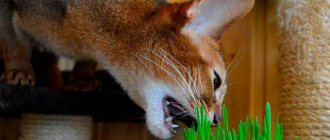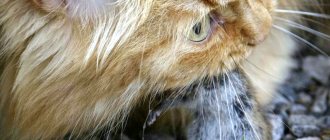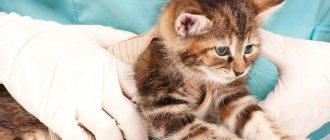How to combine your love for cats with making a profit? You can start breeding them. In order for cat breeding to become a profitable activity, you need to take into account a lot of nuances: calculate investments in the business and the financial return from it, decide on the breed, buy pets, select and equip premises, advertise your services, determine the price of live goods, resolve legal issues.
Reproduction of cats, where to find a cat, sexual behavior
Reproduction of cats, advice for cat lovers.
Reproduction of cats - If you are planning offspring, then it is useful for you to know that female cats reach sexual maturity at 7-12 months, and males at 10-14 months. For most breeds, having more than one litter per year is not desirable. The exception is Siamese cats; they can bear offspring without harm to their health every 7-8 months.
Reproduction of cats. How to find a worthy stud cat.
If you are the owner of a purebred cat, but nevertheless are new to the business of breeding cats, then you need to entrust this matter to a specialist. This could be a veterinary clinic or a breeder of purebred cats. What you need to know.
a conscientious breeder has a specially designated room for a male cat;
the room should be warm, cozy, private and clean;
all animals have appropriate pet health certificates (be prepared that you will also be asked to provide such a certificate);
to use the manufacturer, you will need to pay its owner. If the first coating is unsuccessful, then the cat is brought for mating a second time for free.
Reproduction of cats. When can a cat become pregnant?
A cat's reproductive cycles are seasonal, most often beginning in January, reaching a peak in March-April, June and September. October to December are usually absent, although there are exceptions. Sexual cycles are completely dependent on the length of daylight hours, so in cats that do not leave the house, sexual cycles appear all year round under the influence of artificial light. In each phase of sexual activity, there are 2-3 sexual cycles lasting two weeks. Estrus (hunting) lasts 2-4 days.
Reproduction of cats. Sexual intercourse.
Ejaculation occurs immediately after insertion of the penis into the vagina and is often accompanied by a short and shrill meow from the cat. Having separated from the female, the cat moves away and watches the cat. At this time, the female rolls on the floor, stretches out, spreading her paws. Voluptuously releases its claws. After 5-10 minutes, the mating process is repeated. Mating can occur several times a day.
Reproduction of cats. Courtship.
Even if a cat is completely ready to mate, she often resorts to a certain ritual, driving the cat away and rejecting his advances. She hisses and extends her claws. The cat perceives such aggression from the female passively: he does not fight back, but, dodging the blow, again resumes attempts at courtship. With a plaintive meow, the cat asks for “the lady” and expects a more acceptable answer from her. This game lasts until the cat softens to the inviting meows and turns its back to its “suitor.” This is the signal to start mating.
Homecoming.
When you take your cat home, she may still be in heat, so don't let her out of the house. If after some time the cat again demands a gentleman, this means that fertilization has not occurred and the cat will again have to be taken to the breeder.
Health to you and your pets.
Myyyyyyyyyyyyyyyyy love cats.
Nursery equipment
One of the most important stages in creating your own nursery is ensuring its material base. Animals should be kept in conditions that are comfortable for them; they should have enough not only the care and love of the owner, but also space. Animals can be raised in two types of premises:
- At home. Here it is worth understanding that animals need space, including for mating (a cat and a female cat are usually isolated in a separate room) and for raising offspring. Good ventilation, the ability to not depend on weather conditions and the services of public utilities (we are talking about air conditioning in the summer and own heating, including underfloor heating, in the winter), accessibility for high-quality cleaning - all this will make both breeding work and joint work comfortable. living with furry champions. The downside is that in an apartment, especially if there are children in the family, you can’t have many cats. Experienced breeders recommend having no more than 2 pairs of animals or 3-4 cats if kept at home (with the condition that outside cats will come for mating).
- In an area specially designated for animals, where people do not permanently reside. Provided that such a house is provided with everything necessary (water supply, heating, electricity, ventilation, etc.) and with an area of about 70 square meters. m., you can simultaneously keep up to 15 pets. Here it is worth understanding that it is no longer possible to cope with such a scale alone; for quality care you will need to attract additional people.
When starting a small cat breeding business at home, you need to purchase:
- temporary cages; it may be necessary to isolate one of the pets during illness or heat;
- carrying bag - needed for trips to exhibitions or to the veterinary clinic;
Special carriers are simply necessary for any breeder, because the cat will have to be regularly taken to exhibitions, breedings, and to the veterinary clinic
- beds, houses - each cat should have a corner where it will feel comfortable;
- trays according to the number of animals and litter for them - cats are very clean, and if there are several of them, and there is only one toilet, then the owner will encounter unpleasant surprises in the wrong places;
- bowls for water and food;
- cat food;
- hygiene products (shampoos, combs, wool powders);
- scratching posts - domestic predators will definitely look for a place for their claws, and if you do not provide it to them, then all the corners and furniture in the house will suffer;
- toys, there are a lot of options here - from simple balls and mice to entire play complexes with beds and scratching posts.
You can purchase a whole complex for cats, where they could relax, play, and sharpen their claws
When calculating your costs, it is worth considering that some purchases will be permanent (in particular, food and litter for the tray), while others will last a long time (houses, bowls, carriers).
Where to begin
Despite the fact that cats sleep 20 hours a day, they require increased attention the rest of the time. You need to play with them, you need to scratch them, stroke them. Moreover, cats must have their own home. Therefore, it is better to breed cats at home if you have your own private house with additional premises. So, what do you need for this?
Place arrangement
First of all, you need to build a “cat” town. Someone is building an enclosure fenced with mesh. Some simply allocate a room, arrange it, and place cats in it. However, both locations must have the following facilities:
A place where the cat will eat. It should be a comfortable place. Moreover, feeders must be positioned so that cats do not stretch their necks down. This can have a detrimental effect on the spine. Water can be placed next to food. But cats will look for another source. It is generally accepted that cats perceive water near food as a trap. Moreover, many breeders notice that cats, even in the absence of other sources of water, do not drink water near food. Try it and find out what your animals want. But remember, the cat will eat where it was first given food.
Specially built stairs, climbs, artificial hills. Animals should be able to roam wherever they please. Moreover, there should be houses where cats can hide. Sometimes they like to be alone. The houses should be dark, warm and soft. Cats are primarily heat-loving animals. Moreover, they like to sleep on soft things. Sometimes they need to take cover. Therefore, this option should also be provided.
Arranging a place for breeding cats
There must be toilet facilities provided for cats. Moreover, there is a separate one for each. But many breeders who have their own cat breeding business say that sometimes cats visit other people’s latrines. Well, let it be, the main thing is not in the corners. In order to avoid smell, first of all, you need to clean more often. Moreover, you need to purchase toilet filler that absorbs odors. In addition, the cat will not go to the dirty toilet. Moreover, she will be forced to look for a new place. Most likely it will be some kind of corner. Be careful.
A cat house must have facilities for cats to sharpen their claws. You can make them yourself. Moreover, it's simple. It is enough to find several blanks, wrap them with a large-diameter linen cord, and secure them in places accessible to cats. Moreover, cats must be taught to sharpen their claws here. Otherwise the whole house will be torn apart.
There should be a lot of toys in the “cat” kingdom. Moreover, some toys should be bought that are useful. So that cats can eat them over time. Such toys are made of special edible material. In general, cats like it when something rattles in a toy.
Moreover, you need to understand that the business of breeding cats at home of different breeds requires its own care. Therefore, first of all, you need to decide which breed of cat will be easier for you to breed. To do this, you need to study all the available information. It is better to do this not on the Internet. Moreover, the information is often unreliable. The most reliable sources are printed publications. Don't be lazy, go to the library. After all, your business of breeding cats at home directly depends on cat care. However, for profitable sales, you need to write a business plan yourself.
Feed
In addition to a cozy home and a clean toilet, cats need food. It is necessary to buy the highest quality food for each specific cat breed. Moreover, some breeds are very capricious. What a Siamese eats may not suit a British dog at all. However, you need to find out. The cat’s behavior, type of coat, and overall health depend on the food.
Selection and equipment of premises
The room for keeping animals should be spacious, warm and bright. When living in a private house, it is advisable to allocate a separate large room for pets.
If possible, males, females and new four-legged mothers with babies should be housed separately. So that your children can frolic in the fresh air, it is better to make an open enclosure for them - an area fenced with a net, equipped with a canopy, opaque partitions and equipped with ventilation, heating and lighting.
The room where pets are kept must have:
- cells;
- carrying;
- stable and convenient bowls for food and water;
- trays (it is better to choose models with a grid and without filler, as they are easier to clean);
- cat litter (it is recommended to use granular or wood litter - they absorb odor better, which is especially important when keeping animals in large numbers);
- toys;
- high-quality ready-made food or self-prepared food from good products;
- care products (pet shampoos, combs for combing (they must be selected taking into account the characteristics of the coat of a particular breed), trimmers, toothbrushes and pastes, solutions for cleaning eyes and ears, nail clippers);
- houses where pets could retire;
- scratching posts;
- rugs
Business plan for breeding purebred cats
Breeding cats as a business, although pleasant, is not the easiest activity. To start breeding these animals, you need to calculate all the risks that may arise during the work process. Drawing up a business plan, the purpose of which is to calculate investments and approximate profits, will help to minimize them
It is also important to study information about which breeds are the most profitable
Finance: how much do you need to invest and how much do you plan to receive?
A business plan allows you to calculate only approximate costs and profits. If investments at the initial stage can be calculated as accurately as possible, then income can be calculated very approximately. How much money it will take to become a breeder of purebred kittens depends on many factors. This is influenced by the region, the planned number of pets, the value of the breed, whether the nursery will be built independently or with outside labor, etc.
Information on the approximate costs of creating a nursery with 10 kittens:
| Expense item | Costs, thousand rubles | ||
| Menstrual | Annual | ||
| One-time | Construction of an enclosure for pets | 150 | |
| Purchasing animals | 400 | ||
| Purchase of inventory | 100 | ||
| Expenses for veterinarian services, registration | 50 | ||
| Permanent | Keeping cats (food, care) | 50 | 600 |
| Nursery maintenance (water supply, electricity/gas, heating) | 80 | ||
| Other (advertising, matings, participation in exhibitions, club membership) | 150 |
Based on the figures given in the table, breeding cats at the initial stage will require about 1.5 million rubles. Each of the 8 cats kept in the nursery (the remaining 2 are males) will give birth to at least 4 kittens per year. 32 – number of pets intended for sale per year. The amount of proceeds from their sale will be 1.28 million rubles. (32x40 thousand rubles).
Calculation of business profitability:
(Income – expenses) x 6% = (1,280,000 – 880,000) x 6% = 24,000 rubles. This is the determination of the amount of taxes under the simplified taxation system (STS). Income – expenses – amount of taxes = 1,280,000 – 880,000 – 24,000 = 376,000 rubles. This is the profit for the year.
The most profitable breeds
Having decided to start breeding purebred cats, you need to study which breeds are popular in a given area. You should not focus only on this factor, because, most likely, among the buyers there will be not only local lovers of these animals, but also residents of other regions. Having no experience in this field, it is recommended to start with breeding unpretentious breeds. You need to choose only from those that bring the most profit. These include:
Why is it believed that cats should not be cut, how often can pets be trimmed or shaved, and how quickly do they grow overgrown?
Maine Coon cats
- British;
- Maine Coons;
- Canadian and Don sphinxes;
- Siamese;
- Persians;
- Siberian and Russian blue cats;
- fold-eared Scots;
- Abyssinians;
- Bengals;
- Kurilian bobtails.
Rare and expensive cat breeds:
- savannah;
- chausie;
- Burmilla;
- Peterbald;
- Manx.
Savannah cat and kitten
Cats are divided into classes:
- Show class. Animals absolutely comply with the breed standard, have no defects leading to disqualification, and can take part in the exhibition. The presence of such an ancestor in the pedigree increases the cost of the kitten.
- Breeding class. Cats in this category have minor defects and therefore cannot participate in exhibitions. Their advantages: defects are not inherited, affordable cost, no problems during breeding.
- Pet class. Such animals have serious disadvantages that do not allow them to participate in exhibitions and breeding. However, they usually have documents confirming their belonging to a particular breed, and they are bought by people who do not intend to exhibit them or obtain offspring from them.
What do you need to know and be able to achieve success?
Recommendations for future breeders:
- provide pets with the most comfortable conditions;
- do not feed animals with cheap food, trying to save on their maintenance;
- buy cats that can make a profit;
- officially register your business, otherwise tax evasion will later backfire;
- sell animals at an adequate price;
- before breeding, learn how to properly care for animals;
- know how to properly breed animals and be able to deliver births to pets;
- avoid reputational risks (sell quality animals, do not inflate their prices, deal with customer complaints);
- undergo training in felinological courses.
Cattery: Legal status
Nurseries do not require state registration or licensing. To open your own nursery, you must firstly decide on the breed, secondly, get the first animals, and thirdly, join any of the existing clubs and submit an application there. Next, the club, working according to one of the international systems, will forward the application to the central office of the organization, where specialists will check the name chosen for the nursery for uniqueness, and within a week they can assign the nursery official status.
The owner does not even need to create a legal entity or register as an individual entrepreneur: in the eyes of Russian legislation, the purpose of his activities is not to make a profit on a regular basis. For this reason, legal relations with clients and taxation in this area are not regulated.
Often, nursery owners doubt whether to enter into an agreement with a client when purchasing a kitten or not, because if an agreement is concluded, they must pay personal income tax on the sale in the amount of 13%. Sometimes the owners of nurseries, when transferring kittens into the hands of new owners, draw up an agreement for the transfer of property rights or a gift agreement (tax rate - 13%), but most still prefer to do without documents.
Some factories are raising the issue of whitening their income and including nurseries in business activities. But for now this question remains open.
The most popular breeds in Moscow:
- Oriental and Siamese cats
- Scottish fold (Scottish folds)
- Canadian Sphynx
- British Shorthair
- Russian blue
- Persian cat, exotic
- Abyssinian cat
- Don Sphynx
- Kurilian Bobtail
- Siberian breed
In addition to the tax issue, nursery owners sooner or later face litigation and complaints. The initiators of the proceedings can be both suspicious neighbors and buyers of kittens. In accordance with the Civil Code of the Russian Federation, animals are property, although general rules on property apply to them with some reservations (Part 1 of Article 137 of the Civil Code of the Russian Federation). It is customary among lawyers to say that an animal is an animate thing. Therefore, the cat can be sold, donated or exchanged.
There are no documents protecting animal rights at the federal level. The only exception is Article 137 of the Civil Code of the Russian Federation: when exercising property rights in relation to an animal, cruel treatment that is contrary to the principles of humanity and Article 245 of the Criminal Code, which provides for liability for callous treatment of animals, is not allowed. But liability under this article occurs only if the animal torturer has hooligan or selfish motives, uses sadistic methods, or commits his actions in the presence of minors. Neither keeping in crowded conditions, nor savage training methods, nor other cases of inhumane treatment can be grounds for filing a complaint with the police against the torturer while the animal is alive and well. In essence, criminal liability arises for crimes against the population and public morality, and not against animal rights. When organizing a nursery and breeding animals, it is necessary to remember the Code of Administrative Offenses - Article 6.4 of the Code of Administrative Offenses provides for liability in the form of a fine for violation of sanitary and epidemiological requirements for the operation of residential premises. Sanitary and Epidemiological Supervision Standard SanPiN 2.1.2.1002-00 “Sanitary and Epidemiological Requirements for Residential Buildings and Premises”, approved by the Ministry of Health of the Russian Federation on December 15, 2000, prohibits owners and breeders from using residential premises for purposes not provided for in the design documentation; carry out actions that are a source of increased levels of noise, vibration, air pollution, or that violate the living conditions of citizens in neighboring residential premises; litter, pollute basements, stairwells and cages, attics and other common areas.
In other words, if there are unpleasant odors in the apartment and constant cries of animals are heard, then the neighbors have every right to contact the SES. Also, residents of the house have the right to complain if a neighbor uncontrollably lets cats out to roam freely, and they leave their marks in the entrance or other common area.
As a result of this check, the violator may be issued a fine. It is also necessary to take into account the norms of regional legislation. For example, in Moscow there is a law “On penalties for violations of the legislation of the Russian Federation in the field of animal protection and temporary rules for keeping dogs and cats in the city of Moscow.”
General information
Finding simple income
Therefore, only a large nursery can count on an acceptable profit. For private breeders, cat breeding is more like a self-sustaining hobby than a stable income for a living.
We bought a cat or cat and decided to start breeding
It is not uncommon for communication with your purebred pet, its success at exhibitions and flattering comments from friends to suggest that such a beautiful animal must breed. On the one hand, show champions are regularly invited to breed, especially if they are males. Kitties often remain on the sidelines, since bearing and feeding offspring is work that not every cat owner undertakes.
On the other hand, the success of a cat at shows and his external charm sometimes does not mean at all that he can participate in replenishing the breed base. Sometimes a seemingly ideal cat has hidden genetic diseases that are revealed in the very first litters of kittens and it is obvious that it is impossible to continue breeding with this particular animal.
The cat has to give birth, it's for health
This statement is a myth generated by elementary ignorance. The cat does not have to give birth; there is even nothing wrong if she was sterilized before her first heat. Domestic cats do not pursue the goal of preserving the population, like yard and ownerless cats, because they die on the street faster than domestic cats die, which means that if they do not give birth, they will disappear as a species.
Domestic cats, and especially purebred ones, are not under threat of extinction. They don’t need to give birth “just to have it”; a one-time litter does not affect their future health in any way.
It is even recommended to castrate cats, because their regular rutting is a problem not only for the owner, but also for the animal itself, which suffers from the play of hormones.
I bred hamsters, it's time to start cats
The breeding of each animal species has a number of categorical differences from each other. Starting to breed cats, even if you have already been breeding dogs, is not at all the same thing. Moreover, the experience of breeding ferrets, hamsters, and guinea pigs in “kitten production” is completely inapplicable.
“I have repeatedly kept cats of the same breed, I have exhibition experience, I know many like-minded people and I want to contribute to the development of the breed’s studbook or develop a new hybrid”
Kittens for sale
Purebred kittens, upon reaching the age of 3 months, can already be given to new owners. Considering how quickly cats grow, advertisements are posted almost immediately after birth. The price is set solely at the request of the breeder, but in this matter it is important to rely on the average price tag of competitors, the amount of merit of the kitten’s parents, but most importantly, on the quality of the animal. If the baby meets the breed standard as closely as possible, then the price for it should be high.
Main sales routes:
- through a club - people who are looking for a purebred animal for themselves often turn to famous clubs, where they receive contacts of breeders who have recently had offspring;
- at exhibitions - at open cat exhibitions there are many visitors, they not only look at the judges’ assessment of the animals, but also often look closely at the babies brought by the owners, this path requires financial costs - it is necessary to pay for participation in the event;
- privately by advertisement - the costs and scope in this case vary greatly: from free advertisements on Internet boards to commercials on local television.
The sale of purebred kittens can be made both through personal channels and through a club
Concerned about your reputation and the future of the kids, it is recommended to enter into a cat purchase and sale agreement with the buyer. Its content implies that the new owner undertakes to:
- proper cat care;
- providing the pet with comfortable living conditions;
- monitoring the kitten's health.
Often such contracts stipulate conditions under which the breeder can take the kitten back with or without reimbursement of its cost. The conclusion of such a document is not a mandatory measure, but often it is what helps protect cats from poor living conditions and early breeding.
Pregnancy and childbirth
After successful mating, healthy cats become pregnant. Its duration (depending on the breed) is from 6 to 8 weeks
While carrying kittens, the animal should be cared for with the utmost care, and the diet should be monitored even more carefully.
When carrying kittens, a cat's appetite often worsens. You should be concerned if the animal does not eat anything for more than a day. In addition, attacks of vomiting, lethargy, and inactivity are not excluded. Over time, the negative symptoms disappear, and the appetite increases significantly due to the growth of the kittens.
Brood
It is recommended to give your pregnant cat food that is maximally enriched with vitamins and other beneficial substances. This is necessary not only to obtain a healthy brood, but also to preserve the health of the mother herself.
You can determine the approaching birth by the behavior of the animal. Before the birth of kittens, cats experience a nesting phenomenon, in which she independently prepares the most convenient place for future parental activity. In addition, the pet regularly licks itself in the genital area and becomes restless. There is an increase in mammary glands.
During childbirth, it is best not to disturb the animal in any way to prevent injury to the kittens. The cat independently licks newborns and feeds them. Kittens are born in turns, and therefore the duration of labor directly depends on their number. On average, it can take up to 6 hours for one litter to be born.
During childbirth in a cat, it is not recommended to interfere in any way with the process, or try to eliminate pain in the animal with the help of analgesics.
Disadvantages of the "cat" business
It should be noted that the idea of breeding cats also has negative sides. In this case, a lot depends on the desire of the entrepreneur himself, and how much he loves animals. Some cat breeds have a very capricious and whimsical character, which creates many difficulties in everyday life.
The main disadvantage of the cat breeding business is the significant time investment. In addition, the breeder will need a large supply of strength and patience.
High competition
Kittens require constant care, which includes not only regular feeding, but also bathing, litter box training, and proper upbringing. The possibility of diseases that will require costs for medications and specialist services should not be excluded.
Another disadvantage of the “cat” business is high competition. Breeding purebred animals for further sale is not a new type of business, but it has gained significant popularity due to the appearance of breeds that were previously extremely rare. On the other hand, competition is fully compensated by the high demand for pedigree animals, and therefore does not cause significant difficulties.
In general, cat breeding as a business has certain disadvantages, but if you have the necessary qualities and knowledge, the difficulties that arise can be overcome without any damage.
What to pay attention to
Decor
Pedigree cats, unlike yard cats, are demanding when it comes to food, rest and entertainment. You will not be able to leave the breeding female dry food in the morning and leave the house until the evening. Poor diet and quality of nutrition will affect her health, and at the same time the income from future offspring. Even the color and smoothness of the coat largely depend on the care of the pet.
Most breeders do not register their business, because there is not a word about nurseries in the legislation. Unregistered business activity is illegal, although in the case of cat breeding it is almost elusive and difficult to prove. Moreover, for most breeders this business is not the main one, but only brings additional income. Among them are professional veterinarians, farm and pet store owners. They just need to include the corresponding OKVED in the documentation.
Those who take on a business as their only one should seriously think about the risks.
Choosing a breed for breeding
There are over 100 species of purebred cats, but only some are in demand and suitable for a cattery (especially if it is domestic). Elite breeds are more expensive and require more expenses, and due to their high prices they are not in demand. The most common breeds for breeding are:
- Scottish fold (5-40 thousand rubles per kitten).
- Maine Coon (15-50 thousand rubles per kitten).
- Bengal (10-50 thousand rubles per kitten).
- British longhair and shorthair (10-50 thousand rubles per kitten).
- Manx (on average 30 thousand rubles per kitten).
- Sphinx (5-35 thousand rubles).
The price depends on color, coat length and other things. To properly organize a business, you should not take on breeding more than two breeds at once - analyze the characteristics of different cats, study demand, prices, estimate the costs in advance and make a choice.
Nursery premises
Without additional finances, you can keep stud cats and offspring in your home (ideally in a private home, fresh air and the opportunity to walk have a positive effect on the health of the tailed cats). In any case, it is necessary to allocate a separate room for living, development and recreation. There are beds, drinking bowls, bowls, scratching posts, educational paths, toys, and horizontal bars.
If you purchase several cats or even pairs, consider zoning the room, since a female who has given birth with kittens should be located separately. For several months to six months, the cat should not be allowed near her.
Necessary costs and actions
Many novice breeders stop after their first attempt at breeding cats and move on to something else. The reason is high costs, often not recouped, which must be borne one-time or regularly:
- Producer female. Its price depends on the breed, age, pedigree. From 15-20 to 100 thousand rubles.
- Mating or male for mating (when buying a cat, you will need to double the fixed maintenance costs) - up to 50 thousand rubles. However, if you know someone you can find a free option.
- Food (about 10-20 thousand rubles per year per animal) + complementary feeding of kittens before sale.
- Trays, fillers (2-3 thousand rubles per year).
- Tools and care products (nail clippers, shampoos, brushes, special baths).
- Medicines for prevention and treatment (for fleas, worms, lichen).
- Veterinarian services and vaccinations. Routine examinations, ear cleaning, tests are a prerequisite for breeding cats. On average, you will spend 1-2 thousand rubles per visit. Vaccines are given to kittens 2 times after birth (about 1.5 thousand rubles), a veterinary passport is issued, annual vaccines for breeding cats cost up to 1 thousand rubles. Treatment costs are difficult to predict.
- Participation in exhibitions (without them you will not be able to breed cats, since this is where experts evaluate animals and give diplomas). Participation price – from 2 to 25 thousand rubles. + purchase of an exhibition stand or cage.
- Joining one of the “Cat Lovers Clubs” or registering a cattery in felinological systems (CFA, WCF) will cost approximately 1-1.5 thousand rubles. + annual fees. This is also mandatory, since it is these institutions that issue metrics and pedigrees for the offspring born to you. In addition, it is easier to find buyers through them.
Choosing a breed for breeding
Standardly and most often, the following breeds are selected with the average market value of kittens (in rubles):
- British or Scottish fold - 5,000-40,000.
British cats
- Canadian Sphynx - 15,000-75,000.
- Siamese - 15,000-100,000.
- Russian Blue - 10,000-70,000.
- Maine Coon - about 40,000.
- Persian - 5,000-80,000.
These breeds are quite easy to breed, but they are also very widespread, which is why the cost of kittens is low.
It is more profitable to deal with expensive breeds - Savannah, Caraquet, Chausie, Snow Shoe, Exotic Shorthair, Bengal, Toyger. But this will require more investment, special knowledge and labor.
Caraquet
When choosing a breed, you should also remember about the character of the pets. For example, active cats (Siamese, Bengal, Toyger) will need a large area. Others (the same Siamese or Abyssinian) are very talkative and do not shut up for a minute. Exclusive hybrid cats are quite capricious, have a wild character and are difficult to tame.
Now let's try to calculate income
Let's say you have two girls.
You can get offspring from them no earlier than at the end of the second year of their life. In this case, you will have to pay for mating with a breeding producer. If he is titled and has high-class offspring, aim for 20,000 rubles (or even more, although these issues are discussed and bargaining is appropriate here). So, by the end of the second year you can get offspring from two females.
On average this can be 12 kittens (puppies). While your nursery is little known, the cost of the babies will be much lower - say, 25,000 rubles. In total it will be 300,000 rubles. Minus the mating, we get 260,000 rubles.
It turns out that your breeding females can pay for themselves in just two years, and from the third they will begin to make a profit. Of course, provided that they mate only once a year (no more often!!!), the animals will not get sick, and the offspring will be healthy and meet the standard.
Preparatory stages of breeding work
To start a business, you need to go through a number of preparatory stages:
- Register the nursery and breeding individuals in one of the felinological systems and in the local club.
- Select and reserve/purchase breeding animals. At the same time, do not forget to check all documents (pedigrees, veterinary passports, purchase and sale agreement).
- If only females are purchased, then find a worthy male (preferably two) for mating and negotiate in advance the possible prices and terms of the mating agreement.
- Prepare a platform for advertising - create a nursery website, profiles on all available social networks, register on special forums and trading platforms.
- Find out about the schedule of annual exhibitions. It is advisable to drive only a cat on them, so it is better to own one. You can also exhibit females, but usually experienced breeders do not do this, since the show animal is always under great stress. It is not worth combining it with pregnancy and childbirth. From 4 months of age, kittens can also be exhibited in shows, but this is most often done for sale. And it is the breeding cat that wins awards and enhances the reputation of the cattery.
Club membership and participation in exhibitions
Cat lovers clubs are public organizations that issue their members with various felinological documentation (pedigrees, metrics, title certificates, etc.), and also organize and hold cat shows.
Membership in clubs is provided on the basis of payment of fees, due to which they actually exist. Club members are provided with some useful features, such as using the club's website where they can post advertisements regarding their pets. However, clubs do not resolve any disputes or consider claims regarding the purchase, sale or breeding of animals. Membership in clubs is entirely voluntary.
If you have any complaints or disputes with the seller of the kitten, you should act in accordance with the concluded agreement. If the issue cannot be resolved peacefully, then you need to write a statement to the court. Cat clubs do not have the proper legal authority to deal with such cases.
Be prepared for the fact that you and your pet will have to participate in exhibitions. Each club adheres to a specific felinological system (international or its own), which determines the requirements for an animal to receive ratings and titles. During the exhibition, participating animals are compared with each other and with the breed standard, and those who best meet the standard are determined.
You may ask, why do you need this? Mainly in order to receive titles and assessments from independent experts, thereby confirming the value of your cat as a representative of the breed and increasing interest in him or her for mating. A positive assessment received at the exhibition means the animal is allowed to participate in mating. These are the modern rules.
You can take part in exhibitions when your kitten is three months old. From the age of six months, kittens perform in the junior class, and after reaching the age of ten months they are allowed to participate in the open class and the scores received begin to be taken into account in the animal’s “career”. The previously obtained estimates are also important:
You will learn an expert opinion about the advantages and disadvantages of your kitten and see its prospects in terms of obtaining excellent purebred offspring. Another reason to start a show career as early as possible is that the animal gets used to the atmosphere of exhibitions from childhood and behaves relaxed at them, and a calm disposition is always highly valued by experts when judging.
If positive assessments are received, then at exhibitions you can look in advance for a pair to breed your pet, meet the owners of the animals you are interested in, and exchange contacts.
Sales and pricing
In order to make a profit, kittens must be sold.
To do this, use all possible means:
- The nursery’s own website and social networks. They need to be promoted online using numerous modern information tools.
- Forums. Most often, this site is occupied by several “star” breeders who sell kittens at high prices. It is very difficult and unpleasant to compete with them.
- Interactive trading platforms. In our country today there is practically one monopolist - Avito. There are actually no free ads there. You can try others, for example, Yulu, but so far their ratings among buyers are low.
- Exhibitions. This is a good tool for selling litter. But for a serious show, an application for participation must be submitted at least two months in advance, that is, planned in advance. Babies from 4 months are allowed to participate, very rarely from 3. In addition, funds must be spent on paying for space and participation, obtaining medical clearance to the exhibition, and no one can guarantee sales. But, as a rule, at large shows, such as the Royal Canin Grand Prix or the Commonwealth (Moscow), there are always a lot of potential and actual clients.
To determine the price of kittens, you need to study special literature and the websites of experienced breeders, and follow publications on the Internet. If there are competent, friendly felinologists in the club, then consult with them more often and listen to their recommendations.
1111
Matings, pregnancy, birth, care of kittens before their sale
Usually, upon reaching 7–8 months of age, pets are already capable of procreation. The most reliable evidence of their body’s readiness to bear and give birth to kittens is the first heat. However, it is recommended to breed cats for the first time no earlier than 1.5 years. You need to look for a partner for mating (if there was no goal of purchasing a cat pair) in advance in special clubs, at exhibitions or through private advertisements.
Only absolutely healthy, vaccinated and dewormed animals are allowed to participate in this procedure. Mating should take place in a calm environment. If problems arise, you need to be able to help the cat. The duration of a meeting between a four-legged gentleman and a lady is on average 3–5 days.
Pregnancy lasts about 6–8 weeks. It is recommended to isolate a pregnant cat from other inhabitants of the cattery. The expectant mother requires special care and nutrition. If problems arise during the process of bearing cubs (prolonged lack of appetite, uncontrollable vomiting, lethargy, etc.), you should immediately call a veterinarian. The desire to create a “nest”, licking of the genitals, anxiety, swelling of the mammary glands are harbingers of childbirth.
Usually cats give birth on their own, but you need to be able to help them if necessary. New four-legged mothers, who need to be isolated from other animals, take care of the babies and teach them independence. If for some reason she cannot feed the cubs, they are transferred to artificial feeding with ready-made formulas for feeding kittens, dry formulas for children, or self-prepared mash. This should be done every 2 hours. 4 weeks of age is the optimal time for the first feeding.
The kitten is ready for sale after it reaches 3 months. Until this moment, he must be vaccinated, pre-treated against worms, activated or registered depending on which system the club belongs to, and metrics done.
Maintenance and care
After acquiring cats, careful care is a necessary condition for the success and profitability of breeding.
Contrary to popular belief, purebred animals can be very whimsical, which makes their maintenance much more difficult, especially in a residential apartment.
Aspects of care:
- Feeding.
Obviously, for elite cat breeds, the daily diet must be appropriate. For feeding, it is necessary to use only special food, preferably of natural origin. It is not permissible to give cats any human food, regardless of its taste. If you have problems with nutrition, you should consult a felinologist. Cat care - Hygiene. For an animal to be healthy, the place in which it lives must be clean. It is necessary to constantly change the filler in the trays and monitor the purity of drinking water. It is recommended to bathe cats at least once every 2 weeks to prevent the appearance of unpleasant odors.
- Preventive examinations. You should visit the veterinarian at least once every 3 months. This is necessary to prevent various diseases that can cause the animal to die. In addition, visits to the veterinarian should be made if an animal is suspected of having worms.
- Games. To be healthy and beautiful, cats need to move. Toys alone are sometimes not enough, and therefore the owner of the animal himself can join the game. Pets definitely need to devote time, otherwise constant boredom will negatively affect the cat’s mental health, which can lead to poor appetite and various diseases.
- Transportation. Often there is a need to transport purebred cats. This can be done exclusively in special mini-transport containers, selected taking into account the size of the animal. When carried inside a container, the cat must have clean water, food, and a place for a toilet.
Undoubtedly, proper maintenance of purebred cats is a very important element of breeding, and therefore it should be treated with the utmost responsibility.
Where to start organizing a nursery
The first thing any business should be based on is not only the desire to make money, but also love for your business. Breeding cats requires constant contact with animals and caring for them, which takes a lot of time, so without sympathy for their pets, it will be either extremely difficult or even impossible for the owner to develop such an idea. If the decision is made, then you should start by studying all the necessary information:
- about cat breeds and the characteristics of their breeding;
- about the necessary conditions of detention;
- about nurseries existing in the city and their offers;
- about the demand for kittens;
- about the costs required to create and maintain a nursery.
The matter starts with registering a nursery, and this procedure can be carried out without yet having a single animal. The owner comes up with an original name, becomes a member of any international club that is represented in his city, and submits an application for registration. When the name is checked and no matches are found with the names of existing nurseries, the registration will be considered completed.
Permission for breeding is usually given by the club to which the nursery belongs. If the breed is rare and has special nuances in matters of mating, then the choice of a partner for mating must be coordinated. Cats are assigned a class depending on their parameters and degree of compliance with breed standards:
- show and top show class - the best representatives of the breed, whose phenotype is as close as possible to the ideal, these are participants and winners of exhibitions that are expensive;
A show class cat is an animal that has all the typical characteristics of the breed.
- breeding class (relevant only for females) – cats for breeding that have some deviations from international standards, but can produce high-class offspring;
- pet class - pets that do not meet standards and are not intended for breeding; often they are not even given a pedigree, which seriously affects their cost downwards.
Choosing a cat
After receiving official status (and, if desired, before it), you can choose cats for yourself. The quantity is not regulated, but here you need to take into account your own material capabilities, free space and time. It is best to start with one cat or a pair (female and male). If such a business turns out to be beyond your capabilities, there will be no problem with a large number of pets.
- Scottish Fold;
- British Shorthair;
- sphinxes (equally Canadian, Don and St. Petersburg);
- Persian;
Persian cats are one of the most popular breeds for breeding.
- Maine Coons;
- Bengali;
- Siamese.
It is important to evaluate local offerings from established nurseries. So, if there are already many Persian breeders in the city, then the competition will be very high
The opposite situation is also dangerous - when choosing a rare and unusual breed, you may find that there will be few buyers, especially considering the high cost of such cats.
When organizing your own nursery, it is best to start with “show class” animals. Novice Russian breeders usually take their first animals from Russian nurseries. Next, the nursery chooses the direction: what color, type, etc. he is going to work on.
The initial investment in creating a nursery is limited to the membership fee for joining a club or association and the cost of purchasing the first animals.
Nurseries advertise the results of their work mainly through exhibitions. Exhibitions allow you to gain recognition, establish contacts with colleagues, agree on cooperation, and receive a prize for your achievements, which will ultimately affect the image of the nursery and, accordingly, the cost of kittens. The cost of participation in one day of the exhibition is 1,700 rubles. You can participate in them from 2 times a month to five times a year.
The kitten breeding business does not require a special area for keeping pets; you can do this in your apartment. Nursery owners are not afraid of either the SES or other regulatory authorities if they handle them with care. The only and main condition in this business is love for your business and animals.
Based on materials from an article by Olga Pugach for the “Business Magazine” project
*The article is over 8 years old. May contain outdated data
01.01.1970
864 people are studying this business today.
In 30 days, this business was viewed 383,350 times.
Save the article to study the material carefully
Experts worth working with
When breeding cats, you will have to constantly communicate with professionals in different fields. With their help, you can solve most problems in a short time, as well as improve your knowledge.
Vet
A good doctor can be found not only in a private clinic, but also in a public clinic. When concluding an agreement with an organization, you will be given a discount.
Representatives of the breed club
The club's management helps with paperwork for animals, finding partners for mating and selling kittens. The participants themselves, who have extensive experience and knowledge, share them with newcomers free of charge during meetings and exhibitions.
Felinologist
This man is an expert on cat breed standards. He will help with the choice of purebred parents and explain the nuances of inheritance of rare colors.
Most professional breeders are involved in judging, so you need to get to know them at cat shows. In addition to completing basic courses, these people are required to have a university degree in animal science, animal engineering or veterinary medicine, as well as a judge's certificate from the WCF.
Advantages and disadvantages of breeding cats
As with any job, raising animals has its positive and negative sides. Any animal, purebred or not, requires time, money and attention. The more cats you have, the more money you have to invest to keep them healthy and well cared for. It is necessary to soberly understand that most of the money received from the sale of cat offspring will go into business - the purchase of food, filler, vitamins, vaccinations and preparations for treatment. Of course, if you have several cats and your own cat, then the costs will be lower; you won’t have to spend money on mating with someone else’s cat. And from each cat you can get up to six kittens, so the profit will be quite good, even despite all the costs.
Breeding cats is a big commitment, you can't just breed your cat and sit around waiting for the kittens to grow up. Unfortunately, cats do not always give birth to healthy or live kittens. You always need to be prepared for the fact that you will have to keep a not entirely healthy kitten for a long time, care for it like a child, and nurse it so that it can have a good and happy life.
First you need to purchase animals. It is clear that not at the “bird market” but in a good nursery, and preferably not in Russia. Then raising them on the right food is also an expense. Then take it to exhibitions and it’s good if your animal is not rejected, because... Anything can grow, even from a super nursery on super feed. Next is payment for mating. Then raise offspring and find buyers who always want cheaper. In general, if for the sake of money, then it’s definitely not worth it. I have an unsterilized cat, I’ll tell you this, it’s not much fun, so I take her to mating once a year. More precisely, I’ll get better, I love kittens, I love playing with them, I teach them to do everything - then they follow me like dogs. But when it comes to selling, that’s where it begins... I feel sorry for the kittens, not all buyers are adequate... well, etc.
Paw
https://www.woman.ru/home/animal/thread/4184555/
They won’t pay off, club animals are very demanding, and if you are an inexperienced breeder, you will most likely suffer losses. And not all of the offspring can be sold (one spot on the skin where it shouldn’t be, and the kitten is rejected; you can only sell it for next to nothing), but for those you sell you must first find buyers. And these exhibitions are endless, all this consumes time and money.
Guest
https://www.woman.ru/home/animal/thread/4184555/
It seems to me that breeding for profit is possible, just buy a few breeds first, a Siamese or a Russian Blue. So this is very profitable, kittens can be sold from 5,000 to 20,000, and this is taking into account 1 kitten, and provided that they are from champions and with a passport, vaccinations and a chip, a kitten can be sold for (from) 25,000 to 40,000 thousand rubles
Evita
https://otvet.mail.ru/question/45696474
Pitfalls when breeding animals
In pursuit of profit, you will have to work hard. Animal breeders are forced to devote all their time to them, and the more cats you have, the less time you have for everything else. When starting your business, you will have to invest a lot. For example, a purebred Maine Coon will cost 20 thousand rubles and more , it depends on the specific nursery and the prospects of the kitten itself. Breeders usually sell at a higher price for breeding. Here, of course, you can cheat and say that you are taking a cat for the family, but in any case you will need a pedigree and permission to breed if you want the kittens to sell at a high price.
Russian blue cat
The breeding of the Russian Blue cat breed was first started in England. In the mid-19th century, Mrs. Constance Carew Cox began work on a new breed. However, without a good basis for breeding, a good result could not be obtained.
The Englishwoman chose an animal from Arkhangelsk as the ancestor for her cats. It was a cat with white and blue fur named Cola
After her, the cat Olga, Limpopo, Moscow, Fashoda, Odessa and Yulia arrived in England from Russia for an “important mission”.
The first name given to the new breed was Arkhangelsk. At first there was confusion between Russian blue cats and British ones. It was only in 1935 that a clear difference between these breeds was recorded.
How to register a business
From 2021, any income is subject to taxation. Cat breeders are no exception.
If your annual income does not exceed ₽2.4 million and there are no employees, you can register as a self-employed citizen and pay the state at a preferential rate of 4-6% of your earnings. In other cases, you will have to register as an individual entrepreneur, which requires:
- statement;
- copy of Russian passport;
- document confirming payment of state duty.
OKVED number 01.49.5 “Breeding of domestic animals”.











